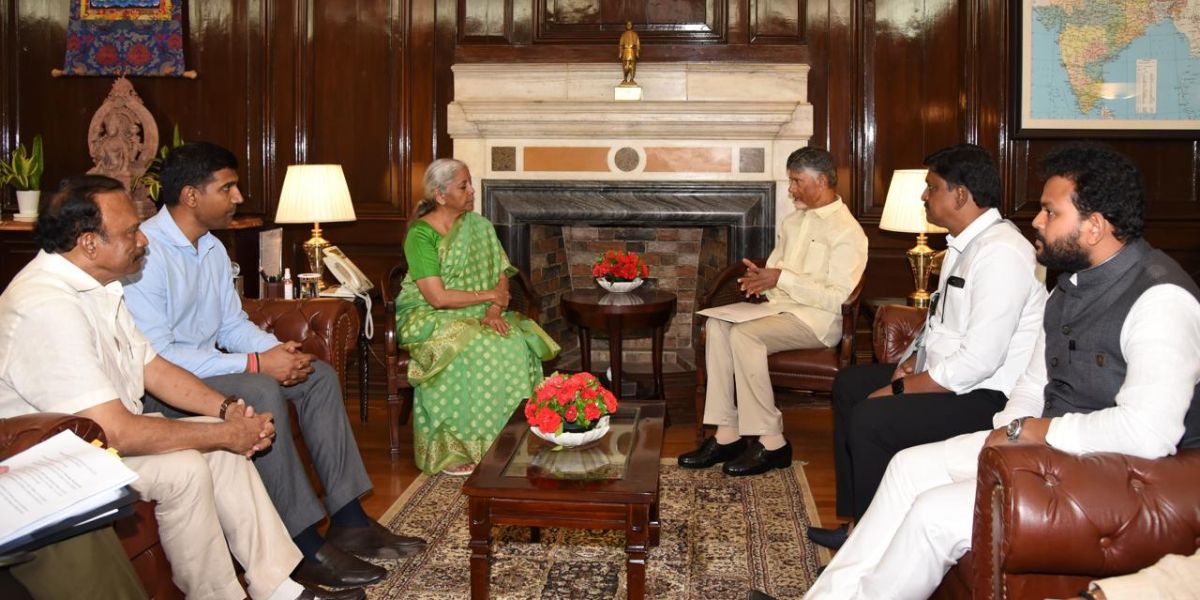While tax collections offer some respite, they remain insufficient to meet the substantial expenditure commitments, both on welfare schemes and major infrastructure projects.
Published Jul 17, 2025 | 3:40 PM ⚊ Updated Jul 17, 2025 | 3:40 PM

Andhra Pradesh Chief Minister N Chandrababu Naidu in a meeting with Union Finance Minister Nirmala Sitharaman. (X)
Synopsis: Despite an uptick in tax collections in Q1 of 2025–26, the Andhra Pradesh government continues to remain in a financial straitjacket. Chief Minister N Chandrababu Naidu sought from the Union government ₹10,000 crore under the SASCI scheme and an additional ₹26,000 crore as an outright grant for the construction of Amaravati.
Despite a modest uptick in tax collections in the first quarter (Q1) of the financial year (FY) 2025–26, the Andhra Pradesh government continues to remain in a financial straitjacket.
During a meeting with Union Finance Minister Nirmala Seetharaman in New Delhi on Wednesday, 16 July, Chief Minister N Chandrababu Naidu sought ₹10,000 crore under the Special Assistance to States for Capital Investment (SASCI) scheme and an additional ₹26,000 crore as an outright grant for the construction of Amaravati, the state’s greenfield capital.
Of the ₹79,280 crore Amaravati project, works worth ₹44,351 crore are already underway. The state now awaits the second tranche of funding from the Union government, which Naidu has requested to be sanctioned as a grant. The appeal underscores the state’s fragile fiscal condition and its continued reliance on Union assistance.
While tax collections offer some respite, they remain insufficient to meet the substantial expenditure commitments, both on welfare schemes and major infrastructure projects. In the Q1 of 2025–26 (April–June), the state reported ₹13,361 crore in total tax revenues, a 2.02 percent increase over ₹13,096 crore during the same period last year.
Analysts view this as an encouraging sign of revenue stability despite broader economic pressures.
The net Goods and Services Tax (GST) collections reached ₹8,860 crore in Q1, showing a 3.40 percent year-on-year growth. On each month of the quarter — April, May, and June — the state posted record GST collections, the highest since the implementation of the Andhra Pradesh GST Act in 2017. In June 2025 alone, the state collected ₹2,591 crore in net GST, including an Integrated GST (IGST) settlement of ₹1,365 crore.
For the full fiscal year, the state’s total revenue receipts are projected at ₹2,18,002 crore, a 24 percent increase over the revised estimates of ₹1,76,174 crore in 2024–25. Of this, ₹1,30,801 crore (60%) is expected to come from the state’s resources, with the remaining ₹87,201 crore (40%) anticipated from central transfers, including the state’s share in central taxes (25%) and grants (15%).
In June 2025 alone, the state’s total tax revenues touched ₹4,167.66 crore, up 6.58 percent from ₹3,910.47 crore in June 2024. GST collections played a major role in this year-on-year growth, rising 7.10 percent to ₹2,598 crore.
In an effort to bolster its fiscal position, the state government is introducing innovative strategies to revitalise the economy, improve tax compliance, and widen the tax base. Chief Commissioner of State Taxes Babu A recently stated that the record GST collections were reflective of improved compliance and a growing taxpayer base.
The reforms include expanding the professional tax base and revising VAT rates on petroleum products. A 70 percent surge in professional tax collections in June 2025 is seen as a result of these initiatives.
Despite a nine percent decline in real estate activity, the sector remains a key focus area, with targeted interventions to stabilise and eventually boost tax contributions.
Large-scale infrastructure projects are also being pushed to spur economic growth, with the state banking on their long-term impact on revenue.
Andhra Pradesh’s reputation for ease of doing business — ranked the best in 2016 — is still being leveraged to attract investments, which officials believe will help broaden the revenue base.
Moreover, being part of the ruling NDA coalition places the state in a favourable position to secure more Central support or accelerate the release of statutory entitlements. The Union Budget for 2025–26 includes provisions aimed at supporting fiscally stressed states, including Andhra Pradesh.
However, a major hurdle remains the burden of committed expenditures such as salaries, pensions, and interest payments. For FY 2025–26, these are projected at ₹55,604 crore — about 25 percent of the estimated revenue receipts — significantly limiting the government’s fiscal flexibility for capital expenditure and welfare rollouts.
Analysts caution that Andhra Pradesh’s fiscal strategy must focus on balancing revenue growth with prudent expenditure management.
Reducing the revenue deficit to 1.8 percent of Gross State Domestic Product (GSDP) and the fiscal deficit to 4.4 percent of GSDP is being attempted.
Addressing sector-specific weaknesses, like real estate and enhancing non-tax revenues, will also be critical as the state continues its delicate financial balancing act.
(Edited by Muhammed Fazil.)
